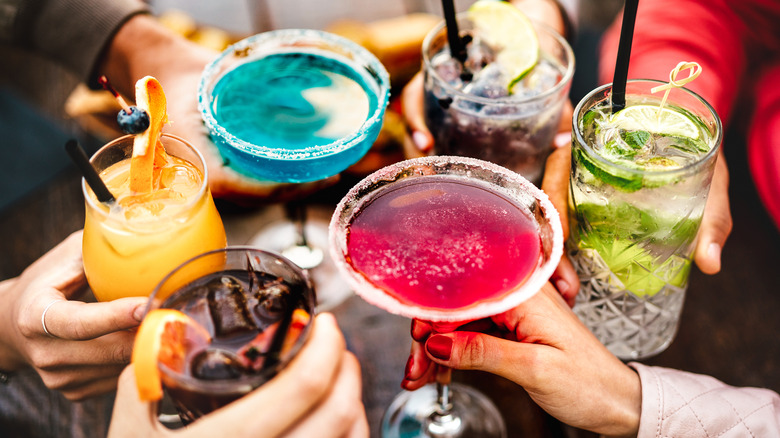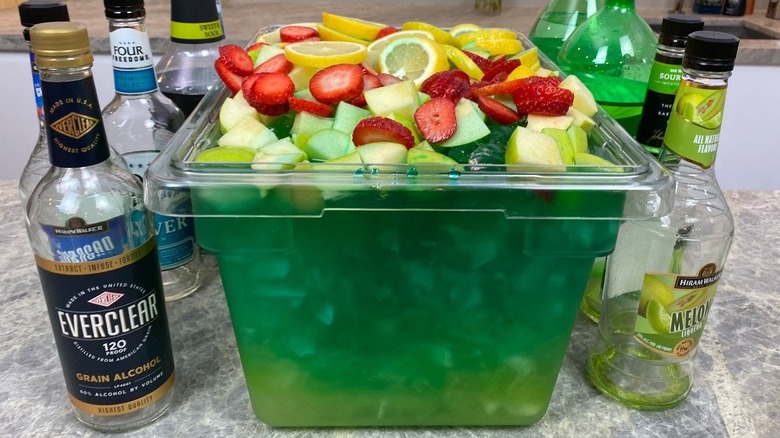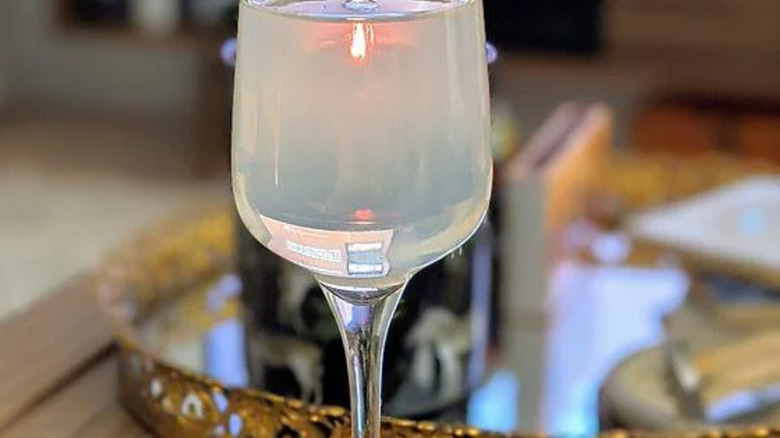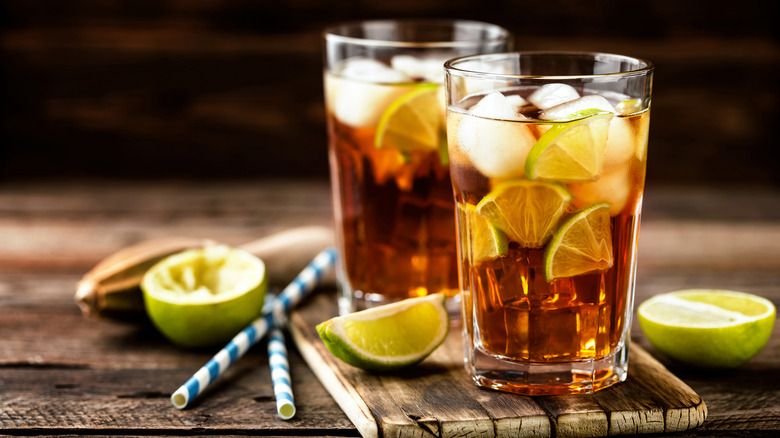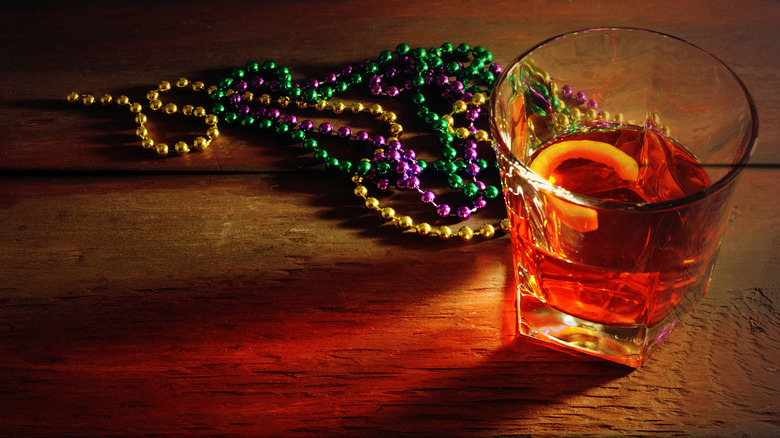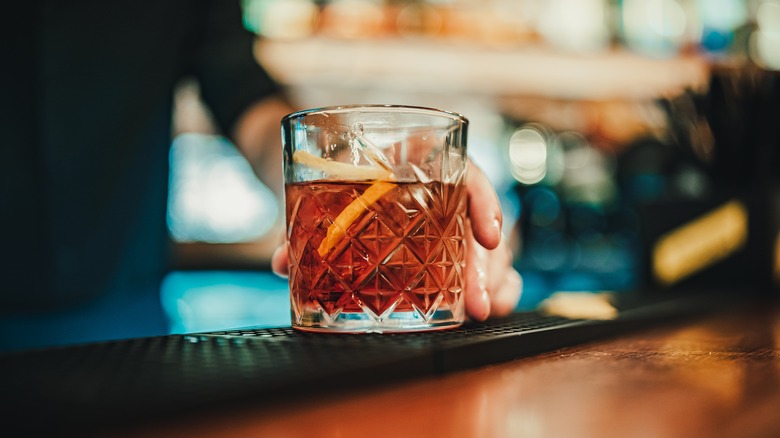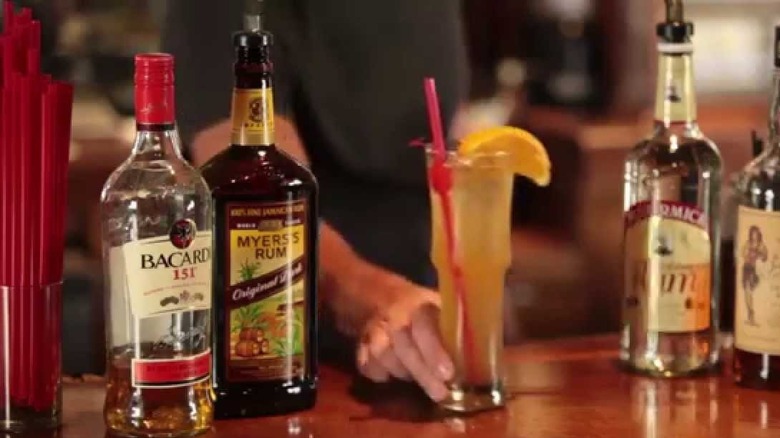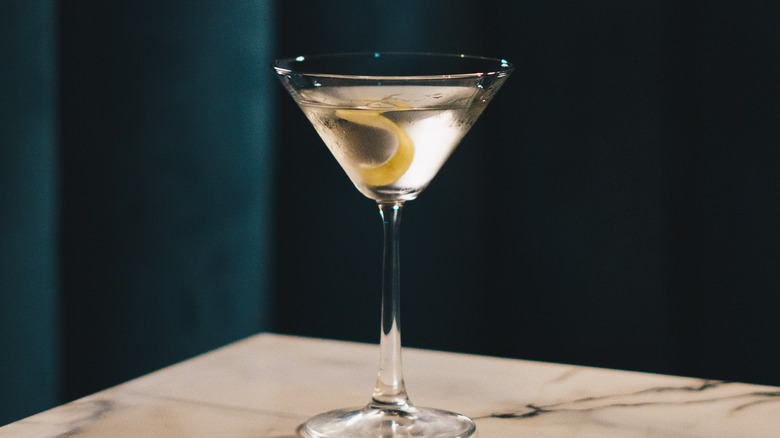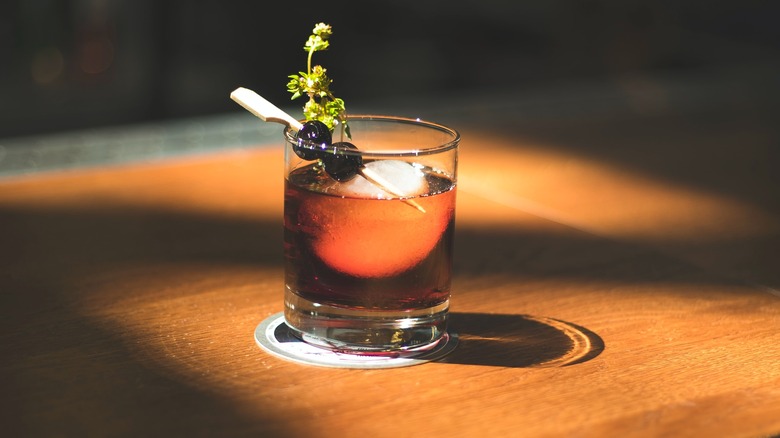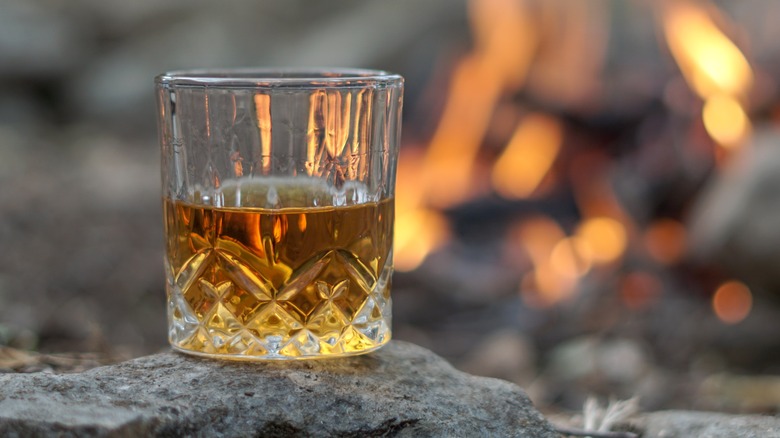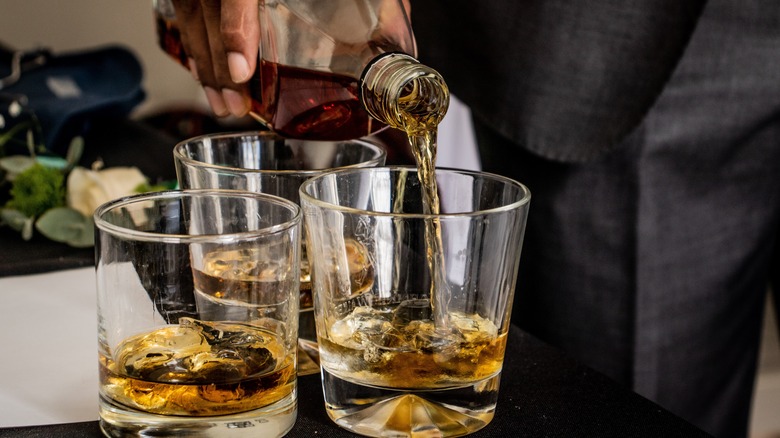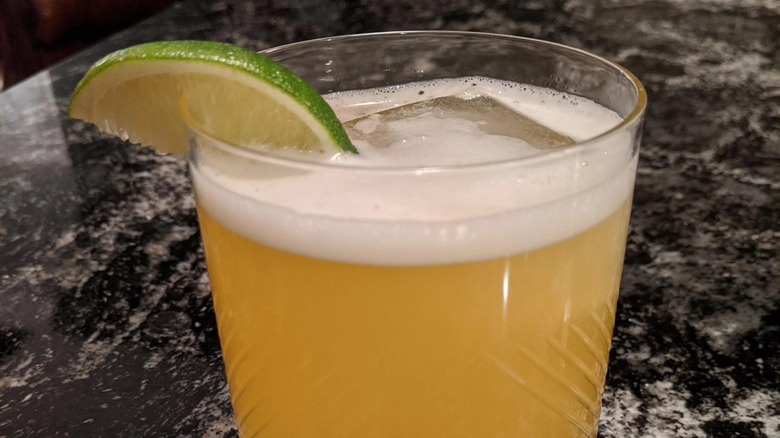13 Intense Cocktails Over 40% ABV
Some drinkers just have a palate for stiffer beverages, the kind of cocktails that possess higher alcohol by volume (ABV) and generally hit much stronger than a run-of-the-mill Cosmopolitan. For those looking to get intoxicated fast without drinking straight hard liquor, there are a number of cocktails running at 40% ABV or higher to help imbibe with a bit more finesse. With mixology techniques often leaning toward blending multiple strong liquors together rather than a fancy presentation and balanced flavor profile, many of these cocktails are relatively simple to make.
Here are 13 of the best and most intense cocktails with an ABV of at least 40%. As always, whenever alcoholic beverages are involved, please drink responsibly and in moderation. With that in mind, here are some of the strongest cocktails that have since been embraced by the wider drinking scene.
Jungle Juice
While Jungle Juice may have its own notorious association with college parties as a quick way to get mind-numbingly drunk, the cocktail has a surprisingly extensive history. The term "jungle juice" was first (reportedly) coined in a 1945 New Yorker article in reference to makeshift cocktails created by American soldiers through DIY liquor stills while fighting in World War II's Pacific Theater (per PunchDrink). The idea of modern Jungle Juice being primarily comprised of grain alcohol and whatever else is on hand remains, albeit thankfully more refined than hastily distilled moonshine.
Historically, Jungle Juice is made with a bottle of 190 proof grain alcohol (95% ABV), two bottles of rum and a bottle of vodka (each 40% ABV), 1 gallon of cranberry juice, 2 liters of lemon-lime soda, and 1 quart of grape juice. These ingredients are poured into a large punch bowl or a clean, watertight ice chest, along with an assortment of fresh fruit that's been washed and cut (via AllRecipes). The concoction is stirred and often left to soak overnight prior to serving to allow the fruit to absorb the alcohol and break down its natural flavors into the cocktail.
Death in the Afternoon
One popular writer known for their love of strong spirits was Ernest Hemingway, the author of literary classics like "A Farewell to Arms" and "For Whom the Bell Tolls." One concoction invented by Hemingway while he lived in Paris is Death in the Afternoon, first listed in a 1935 cocktail recipe book "So Red the Nose, or a Breath in the Afternoon" (per The New York Times). Sharing its name with Hemingway's 1932 novel, Death in the Afternoon blends potent French alcohols and lives up to its macabre moniker. For his part, Hemingway credited three sailors he met for developing the cocktail, advising readers to drink "three to five of these slowly" and claiming it would "put hair" on the drinker's chest.
Traditionally, a Death in the Afternoon is served in a champagne flute, with iced champagne (12% ABV) poured over a shot of absinthe (45% ABV) to create a truly formidable cocktail (via Liquor.com). Variations have the absinthe poured over the champagne instead, due to the sparkling wine's tendency to remain buoyant over the liquor. A weaker variant substitutes Pernod (40% ABV) instead of absinthe while other recipes have a dash of bitters and a crushed sugar cube sprinkled in the glass prior to the addition of the alcoholic ingredients.
Long Island Iced Tea
A popular and quick way to get drunk without tasting the hearty blend of liquors involved is the Long Island Iced Tea, blending a staggering five different types of liquor into a single beverage. According to legend, the cocktail was created by a local figure in Kingsport, Tennessee, known as Charlie "Old Man" Bishop, who devised the drink to circumvent the alcohol ban during Prohibition. The legend continues that Bishop's son Ransom popularized the drink following the end of Prohibition, slightly changing up its recipe to match more common palates. Yet another legend has Long Island bartender Robert Butt introduce the cocktail in a 1972 local contest, with the drink gaining popularity thereafter (per the Culture Trip).
A Long Island Iced Tea has 1/2-ounce gin, vodka, rum, tequila, and triple sec poured over ice in a shaker, with each liquor containing approximately 40% ABV. And 1 ounce of sour mix is added prior to shaking the mixture and pouring into a Tom Collins glass. The glass should then be topped off with cola, with a lemon slice added as a garnish, creating a drink that is deceptively sweet given its alcoholic strength (via AllRecipes).
Sazerac
New Orleans has one of the most robust drinking scenes in the United States, with the French Quarter known for its vibrant nightlife and strong cocktails. A local favorite is the Sazerac, which originated in the city in the 19th century as rye was transported down the Mississippi River, with New Orleans as the last port of call. In 1849, the Merchants Exchange Coffee House was sold by its proprietor Sewell T. Taylor to turn into an importer of spirits, most notably, French cognac (per Sazerac). The combination of French liqueur and American rye served as the basis for Sazerac, which was introduced shortly thereafter.
Traditional Sazeracs involve rinsing the interior of an old-fashioned glass with absinthe prior to adding a muddled sugar cube, 1/2 teaspoon of water, three dashes of Peychaud's bitters, and two dashes of Angostura bitters — then 1.25 ounces each of rye (80% ABV) and cognac (40% ABV) are added and stirred with ice until chilled, with the mixture strained back into the glass and served with a lemon peel garnish (via Liquor.com). In 2008, locals officially voted the Sazerac as the official cocktail of New Orleans further underscoring its cultural significance to the city and representing the Big Easy's penchant for hard drinks (per Esquire).
Negroni
A hearty Italian aperitif cocktail is the Negroni, a deceptively potent cocktail that has helped drinkers imbibe ever since the early 20th century. The beverage was reputedly created by Pascal Olivier, the Count of Negroni, during a visit to Florence in 1919 by requesting a local bartender make an Americano with gin instead of soda water (per San Francisco Gate). In 1947, while filmmaker and actor Orson Welles was making the movie "Black Magic" in Italy, he discovered the cocktail and helped popularize it back in the United States (via The Rake).
Since Welles' endorsement of the beverage, a number of variations of the Negroni have surfaced, including variants that substitute prosecco instead of gin and some that barrel-age the cocktail in whiskey barrels (per Food & Wine). A classic Negroni has 1.5 ounces gin (40% ABV), 1 ounce vermouth (15% ABV), and .75 ounce of campari (25% ABV) stirred together in a mixing glass with ice. Once the cocktail is chilled, it is strained into a rocks glass, with an orange peel added as a garnish (via Bon Appétit).
The Zombie
The Zombie lives up to its name by potentially turning even the hardiest of drinkers into a shuffling, moaning wreck! The cocktail's creation is widely attributed to restauranteur Donn Beach, who owned Don the Beachcomber in Los Angeles, inventing the drink in the 1930s to cure a patron's hangover (per Make Me A Cocktail). Earning its infamous name by making its inaugural drinker seem like a zombie, Beach imposed a two-drink maximum for future customers ordering the beverage.
A traditional Zombie involves mixing three different types of rum (each 40% ABV) with a variety of additional ingredients to mask the flavor and potency of the concoction. Three shots of rum, a dash of Angostura bitters (44.7% ABV), a dash of Pernod (40% ABV), 1 teaspoon falernum (11% ABV), 1 teaspoon lime juice, and 1 teaspoon grenadine are poured into a blender. After blending well, the mixture is poured into a highball glass, with a sprig of mint, lemon slice, and cherry added as a garnish. Some variants remove the Pernod and slightly reduce the ABV by adding grapefruit juice and simple syrup instead.
Nikolaschka
One of the more unique cocktails, both in terms of ingredients and preparation, is the German after-dinner cocktail the Nikolaschka. Though commonly served with cognac as its primary alcoholic foundation, most recipes maintain a double-shot helping of its main spirit be used for that extra kick. Interestingly, the other ingredients are meant to be consumed separately from the beverage component, either right before or immediately after ingestion of the liquid (per Taste Atlas).
A traditional Nikolaschka has a double-shot of cognac (40% ABV) poured into a snifter glass, with a lemon disc covering the top of the glass and teaspoons of espresso powder and sugar placed on top. Some variations in consumption have the ingredients lightly chewed before drinking while others have the solid ingredients used as a chaser. Some Nikolaschka variants replace cognac with vodka and the lemon disc with an orange instead. A popular European variant of the Nikolaschka replaces cognac with the German liqueur Kirschwasser (40-50% ABV), the fruit disc with a slice of salami, and the sweet ingredients with French mustard to make for a more savory experience (via Taste Atlas).
Bone Dry Martini
On its own merits, a classic martini is a relatively powerful cocktail popularized by the James Bond film series as the drink of choice for the iconic British secret agent. For those looking for a stiffer drinking experience than the classic martini, a popular variant is the Bone Dry Martini which eschews some of the mixers to emphasize the hard liquor components. The push for a stronger, dryer martini has led to the introduction of variants ever since the martini's reported debut in 1882 (per Difford's Guide), with the Bone Dry Martini among the absolute driest.
Nearly three times as strong as a standard martini, the Bone Dry Martini is prepared by adding two shots of vodka or gin and six ice cubes to a mixing glass and stirred until ice cold (via Kuletos). The stirred beverage is then strained into a chilled martini glass, with a lemon peel added as garnish, with some variants adding green olives to the mix. With the removal of vermouth, the Bone Dry Martini is virtually a glorified double-shot of vodka or gin but with all the classiness one comes to expect from a martini in the first place.
Aunt Roberta
The purported history behind the Aunt Roberta is one that reads like an American horror story, fitting given the cocktail's sheer alcoholic strength and origins stretching back reportedly as far as the late 19th century. According to legend, an Alabama woman, known simply as Aunt Roberta, branched into the moonshine business with a signature cocktail bearing her name. "Most of the patrons of her establishment were homeless people, and rumor goes that 34 people have died over the two years she sold her homemade concoction." Roberta herself died in 1886, and then raccoon hunter Billy Joe Spratt brought his inspired version of the beverage to New York (per The Booze Snob).
Befitting its moonshine origins, the Aunt Roberta involves a set of formidable liquors combined unceremoniously into a single beverage, thrown together with little more care than Jungle Juice. A shot of blackberry liqueur, two shots absinthe, three shots vodka, one shot brandy, and 1.5 shots gin. These ingredients are either stirred or shaken with ice until chilled and strained into a martini glass, giving this rough-and-tumble cocktail a touch of class that doesn't quite make it any easier going down (via Cocktail Builder).
Four Horsemen
The Four Horsemen is one of those cocktails that doesn't dress up its intent with fancy mixing techniques or inventive ingredients, it's simply a beverage designed to get its drinker intoxicated quickly. The cocktail has four different types of common, big-brand whiskey combined into a single drink, meant to be shot as quickly as possible rather than try to ruminate over its flavor profile and nuances. Named after the biblical Four Horsemen of the Apocalypse, the cocktail trades out fiery shock and awe for easy inebriation and a potential killer hangover the following morning.
Though there are several variations of the Four Horsemen, most recipes involve whiskeys with brand names that all begin with the letter "j." Commonly, the Four Horsemen consists of a 1/2 shot Jim Beam, 1/2 shot Jack Daniel's, 1/2 shot Jameson, and 1/2 shot Johnny Walker Black (all at 40% ABV) poured into a rocks glass (per Go Puff). With only a light stir — if mixed at all — the concoction is meant to be ingested in a single gulp before the drinker realizes the boozy folly (and salacious flavor) they've just committed to.
Jackson Five
Any bad idea stands the chance of being made significantly worse — here, the Four Horsemen is outdone by its spirit-heavy successor the Jackson Five. Rather than simply be content with four different kinds of "j" monikered liquors, the cocktail goes even further — a fifth liquor is added to the mix. As one can imagine, this makes the Jackson Five 20% more potent than a Four Horsemen and certainly no more palatable in its flavoring.
Like the Four Horsemen, the Jackson Five shuns any sort of imaginative mixing techniques or non-alcoholic ingredients to dress up the cocktail. The Jackson Five retains all four types of whiskey from the Four Horsemen with the addition of Jose Cuervo Gold; some variants utilize Jagermeister instead of tequila (per Banana 101.5). Like the Four Horsemen, the Jackson Five is meant to be drank as quickly as humanly possible before you realize what you've just done.
Blue Motorcycle
While the Long Island Iced Tea has been thrilling drinkers since its widespread introduction in 1972, the Blue Motorcycle offers a more refreshing and tropical twist to the beverage without compromising its alcohol content. Instead, the Blue Motorcycle's changes to its cocktail progenitor lean more toward flavor and coloration — with the mixed drink's origins similarly pointing to 1970s New York, though no definitive creator has been identified (per Another Cocktail Blog). While its bright blue coloration and tropical flavor may not be immediately associated with a grizzled biker, the Blue Motorcycle certainly packs a punch.
A Blue Motorcycle contains a 1/2 shot of vodka, 1/2 shot rum, 1/2 shot tequila, 1/2 shot gin, and 1/2 shot Blue Curacao to give the drink its flavor and namesake color. Instead of the Long Island Iced Tea's cola, a Blue Motorcycle uses lemon-lime soda and a dash of sour mix, with the liquors and sour mix shaken with ice until chilled. The mixture is strained into a Tom Collins glass and topped with lemon-lime soda to give it its deceptively sweet and tropical taste (via On the Gas).
Caribou Lou
The Kansas City rapper Tech N9ne has done more than influence future generations of hip-hop artists, with his 2006 track "Caribou Lou" inspiring a cocktail of the same name. As described by the lyrics to the song's chorus, the mixed drink contains two stiff types of liquor balanced with pineapple juice to give it a tropical twist (per Genius). Fortunately, the making of the cocktail isn't particularly intensive, so the Caribou Lou is an easy way to channel some summertime fun in a glass.
As per Tech N9ne's lyrics, the Caribou Lou is made from a shot and a half of 151 rum (75.5% ABV), a shot of Malibu rum (35% ABV), and five shots of pineapple juice. The ingredients are poured into a shaker with ice, shaken well until chilled, and strained into a Tom Collins glass with ice, with a pineapple wedge and cherry used as a garnish (via the Tipsy Bartender). With the inherent sweetness of Malibu and the pineapple juice, the Caribou Lou is a deceptively powerful cocktail, easy going down and strong enough to become Tech N9ne's drink of choice.
